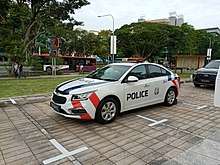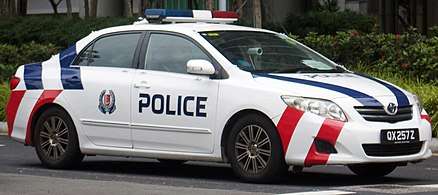Fast Response Car
Singapore Police Force land division officers typically respond to calls in rapid-deployment vehicles now known as the Fast Response Car (FRC) which are the main police cars in Singapore. Prior to 2000, they were known in public simply as police patrol cars.

Fast Response Cars are usually composed of Japanese-made saloon cars. Most commonly seen are the Toyota Corolla Altis and the Hyundai Elantra. Around 2000, Nissan Sunny and Subaru Impreza[1] sedans were added to the fleet. Unlike civilian vehicles in Singapore in which speed limiters (speed governors) are installed to prevent over-speeding, Police Fast Response Cars are able to reach their maximum speed potential without hindrance when the need arises.
Originally restricted to team leader vehicles during the 1990s, all current FRCs carry a large array of equipment to allow officers to conduct normal policing duties and basic investigative work which officers are expected to perform with the implementation of the Neighbourhood Police Centre (NPC) system. A typical FRC vehicle may therefore stock equipment for the force-opening of locked doors, conducting roadblocks, fingerprint collection, and the provision of first aid. Chemical agent protection equipment and bulletproof vests are also carried for the officer's protection.
The Mitsubishi Galant and Opel Astra series of FRCs, which were bought in very limited numbers, were the only police cars in local history to use aerodynamically designed light bars, all other police vehicles to date use the block shaped design.
List of Police Patrol Cars in Singapore History
Current
| Make and Model | Type | In service | Notes |
|---|---|---|---|
| BMW F30 325d M Sport | Sedan | 2018–present | Only used by the Traffic Police Expressway Patrol Unit |
| Chevrolet Cruze NB 1.6D | Sedan | 2016–present | |
| Hyundai Avante HD 1.6 | Sedan | 2010–present | |
| Hyundai Elantra MD 1.6 | Sedan | 2014-present | |
| Hyundai Sonata NF 2.0 | Sedan | 2011–present | |
| Hyundai TL Tucson FL 1.6 GLS | Crossover SUV | 2020–present | Approximately 300 vehicles to be delivered through 2024. |
| Subaru Impreza GD | Sedan | 2006–present | Currently only used for follow-up investigations. |
| Toyota Corolla Altis 1.6 (E120) | Sedan | 2005–present | Currently only used for follow-up investigations. |
| Toyota Corolla Altis 1.6 (E140) | Sedan | 2009–present | |
| Volvo S80 T5 2.0 | Sedan | 2012–present | Only used by the Traffic Police Expressway Patrol Unit |
Defunct
Gallery
- A Toyota Corolla Altis police car at Suntec City during Singapore 2006
- A Subaru Impreza fast response car at Suntec City Mall.
_1.6_Elite_sedan%2C_Singapore_Police_Force_(2016-01-03).jpg) A Hyundai Elantra Fast Response Car in Singapore in 2016
A Hyundai Elantra Fast Response Car in Singapore in 2016 Toyota Corolla Altis wearing the new Singapore Police Force livery
Toyota Corolla Altis wearing the new Singapore Police Force livery
Fast Reponse Vehicle

Originally unveiled in 2002 at the Singapore Police Force's annual workplan seminar, the Enhanced Patrol Vehicle Project was presented to highlight the need for police off-road capability. The Volvo V70 AWD XC, Mitsubishi Space Wagon and Mitsubishi Chariot underwent evaluation in various Neighbourhood Police Centres. They also provide bigger storage for additional equipment like undercarriage mirrors. All NPCs were to have at least three of such vehicles eventually, but as of 2006, only 6 have been purchased in total (3 Volvo V70 XCs, 3 Mitsubishi Space Wagons/Chariots).
The project underwent several evaluations and in 2004, was re-introduced to the public as the new Enhanced Fast Response Vehicle (FRV). This time, consisting instead of modified *Toyota Hilux twin-cab pick up trucks, which utilises diesel-power and provide greater ability to endure high usage on the roads over extensive periods of time. Achieving both the original and new requirements of the project, the new vehicles' bigger storage space also allows for easier storage and retrieval of equipment like chemical agent protective suits and bullet-resistant vests. The SPF plans to have two of these vehicles at all NPCs.[2][3]
The civilian model of the Toyota Hilux vehicles in use in Singapore is the 2-litre turbo pickup truck. The SPF uses the Australian 3-litre turbo 4WD DOHC model instead.
Gallery
 A Volvo V70 XC Fast Response Vehicle on patrol nearby North Bridge Road. Note the lower profiled light bar as compared with the Fast Response Car.
A Volvo V70 XC Fast Response Vehicle on patrol nearby North Bridge Road. Note the lower profiled light bar as compared with the Fast Response Car. A Mitsubishi Space Wagon Fast Response Vehicle doing a patrol somewhere in Towner Road.
A Mitsubishi Space Wagon Fast Response Vehicle doing a patrol somewhere in Towner Road..jpg) A Toyota Hilux Fast Response Vehicle.
A Toyota Hilux Fast Response Vehicle.
References
- They are not to be confused with the Subaru Impreza WRX used by the Traffic Police.
- "SPF's New Fleet Hits the Road". Archived from the original on 4 June 2007. Retrieved 14 November 2018.
- "Home Team Departments" (PDF). Archived from the original (PDF) on 21 February 2007. Retrieved 14 November 2018.
- Goh, J. (May 2006). "SPF's New Fleet Hits the Road". Police Life Monthly. Vol. 32. Singapore Police Force. p. 1. Archived from the original on 2007-06-04. Retrieved 2006-12-29.